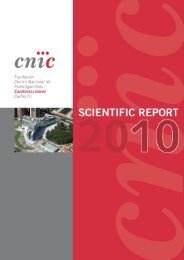Appendix - CNIC
Appendix - CNIC
Appendix - CNIC
You also want an ePaper? Increase the reach of your titles
YUMPU automatically turns print PDFs into web optimized ePapers that Google loves.
SCIENTIFIC REPORT ´09<br />
Stem cell aging<br />
> RESEARCH INTEREST<br />
The INK4b-ARF-INK4a locus encodes three tumor<br />
suppressors, p15INK4b, ARF, and p16INK4a. Together,<br />
these factors constitute one the most important sources of<br />
cancer protection in mammals, equalled in importance only<br />
by p53. These tumor suppressors have taken on additional<br />
importance in the light of recent evidence that at least one<br />
product of the locus, p16INK4a, also contributes to the<br />
decline in the replicative potential of self-renewing cells with<br />
age. Thus, on the one hand, p16INK4a promotes longevity<br />
through its action as a potent tumor suppressor, while on the<br />
other hand the increased expression of p16INK4a with age<br />
reduces stem and progenitor cell proliferation, ultimately<br />
reducing longevity. In other words, p16INK4a appears to<br />
balance the need to prevent cancer against the need to<br />
> MAJOR GRANTS<br />
Head of Laboratory: Susana Gonzalez<br />
Postdoctoral Researchers: Celia Cerrato Rivera<br />
Technicians: Pilar Mendoza Doroca<br />
Christian Torrenteras Ruano<br />
Cristiana de Jesús Oliveira Leite<br />
Antonio Herrara Merchán<br />
Ma Eugenia Alonso Ferrero<br />
Antonio José Montes Ruiz<br />
- Human Frontier Science Program Organization<br />
(HFSPO). Career Development Award<br />
- Ministerio de Ciencia e Innovación. FIS (PI060627)<br />
SELECTED PUBLICATIONS<br />
27<br />
2 Regenerative Cardiology<br />
sustain regenerative capacity throughout life. These<br />
observations suggest the provocative but unproven notion<br />
that mammalian aging results in part from the effectiveness<br />
of tumor suppressor proteins at preventing cancer.<br />
Our group is investigating the role and molecular regulation<br />
of the INK4b-ARF-INK4a locus in the context of selfrenewal,<br />
proliferation and aging of hematopoietic stem cells<br />
in vitro and in vivo, with planned extension of these studies<br />
to cardiac stem cells. In parallel, we are developing tools for<br />
the study of the genetic and epigenetic mechanisms that<br />
regulate stem cells, and how these unique cells differentiate<br />
from a pluripotent to a more restricted state.<br />
The INK4/ARF locus regulates cancer<br />
cell proliferation and stem cell aging, and in<br />
this way may control the balance between the<br />
needs for regenerative capacity and for<br />
protection against the increased risk of<br />
neoplasms with age.<br />
Gonzalez S, Pisano D, Serrano M. Mechanistic principles of chromatin remodeling guided by siRNAs and miRNAs. Cell Cycle (2008)<br />
7: 2601-8<br />
Benetti R, Gonzalo S, Jaco I, Munoz P, Gonzalez S, Schoeftner S, Murchison E, Andl T, Chen T, Klatt P, Li E, Serrano M, Millar S,<br />
Hannon G, Blasco MA. A mammalian microRNA cluster controls DNA methylation and telomere recombination via Rbl2-dependent<br />
regulation of DNA methyltransferases. Nat Struct Mol Biol. (2008) 15: 268-79<br />
de Yebenes VG, Belver L, Pisano DG, Gonzalez S, Villasante A, Croce C, He L , Ramiro AR. miR-181b negatively regulates activationinduced<br />
cytidine deaminase in B cells. J Exp Med (2008) 205: 2199-206



